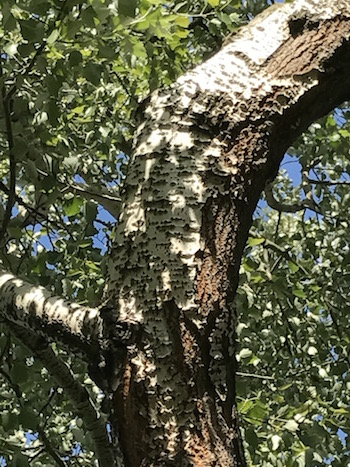
Description:
White poplar is a medium sized, European poplar species that has been widely planted in the United States. Leaves are up to 5” long, alternate, simple, and ovate, with 3-5 shallow lobes. The leaves are bright green, with a wooly white underside. White poplar is dioecious, meaning that trees have either male or female flowers. Flowers of both sexes are drooping catkins. Male flowers are tiny and red, while female flowers are greenish, and develop into dry capsules that open to reveal abundant, cottony seeds. The bark is smooth and greenish-gray on young trees, but matures to a darker gray with ridges and furrows.
White poplar has a large native range in Europe and Western Asia, and was first planted in the United States in 1748. The wood is soft and not often used for timber, but the trees make excellent landscape plants because of their soft, attractive foliage that flutters in the wind. White poplars are associated with the ancient Greek Hercules, who supposedly used a bough of poplar as a victory crown after a battle.
A 2014 paper from the University of Minnesota’s Department of Plant Pathology explored the susceptibility of a white poplar hybrid to the wood decay fungus Phanerochaete chrysosporium. As of 2017, this particular tree is the only example of a white poplar on the University of Minnesota Twin Cities campus.
Issues:
White poplar can propagate from root suckers and can therefore spread quickly when unmanaged. The roots are also quite shallow and cause sidewalk buckling. It is also susceptible to a wide range of diseases, including dieback, canker, and powdery mildew.
Other Resources:







